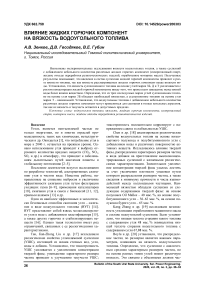Влияние жидких горючих компонент на вязкость водоугольного топлива
Автор: Зенков Андрей Викторович, Гвоздяков Дмитрий Васильевич, Губин Владимир Евгеньевич
Журнал: Вестник Южно-Уральского государственного университета. Серия: Энергетика @vestnik-susu-power
Рубрика: Теплоэнергетика
Статья в выпуске: 3 т.20, 2020 года.
Бесплатный доступ
Выполнены экспериментальные исследования вязкости водоугольных топлив, а также суспензий с добавлением небольшого количества различных жидких горючих компонент (изопропиловый спирт, жидкие отходы переработки резинотехнических изделий, отработанное моторное масло). Полученные результаты показывают, что введение в состав суспензии жидкой горючей компоненты приводит к росту вязкости топлива, так как вязкость рассматриваемых жидких горючих компонент выше вязкости воды. Установлено, что вязкость суспензионного топлива на основе углей марки 3Б, Д и Т увеличивается с ростом концентрации жидкой горючей компоненты ввиду того, что происходит замещение менее вязкой воды более вязким веществом. Определено, что из трех исследуемых марок углей суспензионное топливо на основе угля марки 3Б обладает наибольшей вязкостью, а суспензионное топливо на основе угля марки Т - наименьшей. Установлено, что водоугольные топлива с добавлением небольшого количества различных жидких горючих компонент могут применяться для сжигания в топках котельных агрегатов, так как их вязкость и текучесть остаются в допустимых пределах.
Водоугольное топливо, вязкость, жидкая горючая компонента, изопропиловый спирт, моторное масло, жидкие отходы переработки резинотехнических изделий
Короткий адрес: https://sciup.org/147234063
IDR: 147234063 | УДК: 662.758 | DOI: 10.14529/power200303
Текст научной статьи Влияние жидких горючих компонент на вязкость водоугольного топлива
Уголь является неотъемлемой частью не только энергетики, но и многих отраслей промышленности, таких как химическая, металлургическая и др. Ожидается [1], что потребление угля в мире к 2040 г. останется на прежнем уровне. Однако использование угля приводит к выбросу огромного количества вредных веществ (CO 2 , NO x , SO x и др.) в атмосферу, что приводит к заболеваниям дыхательных путей населения планеты и глобальному потеплению [2–5].
Последние десятилетия ведутся исследования по разработке технологий, альтернативных сжиганию угля в чистом виде. Известны работы, направленные на снижение выбросов и увеличение эффективности сжигания угля путем фильтрации уходящих газов [6–9], применения катализаторов [10], сжигания угля в смеси с биомассой [11, 12], красным шламом [13] и др.
Один из наиболее эффективных и экологически безопасных способов сжигания угля – сжигание в виде водоугольного топлива (ВУТ) [14]. ВУТ представляет собой взвесь мелкодисперсного угля в воде с добавлением пластификатора [15], а также других горючих и стабилизирующих веществ [16]. Однако такая технология имеет ряд ограничений, связанных с ее реологическими характеристиками.
Так, Jian-Zhong Liu и др. [17] исследовали реологические свойства углешламовой суспензии (УШС), состоящей из шлама сточных вод, угля, воды и добавок. Установлено, что тиксотропность УШС усиливается с увеличением концентрации твердой фазы; уменьшение характерного размера частиц приводит к улучшению текучести УШС;
тиксотропность положительно коррелирует с напряжением сдвига и стабильностью УШС.
Chen и др. [18] анализировали реологические свойства водоугольных топлив на основе низкосортного полукокса и полубитуминозного угля с добавлением воды и различных поверхностно активных веществ. Исследовалось влияние твердой фазы, распределения характерных размеров частиц и вида добавок на приготовление высококонцентрированных суспензий с желаемыми реологическими характеристиками. Значительное увеличение концентрации твердой фазы удалось достичь за счет увеличения плотности упаковки путем контроля распределения размеров частиц, а также сведения к минимуму прочности и числа взаимодействий между коллоидными частицами. Наименьшей вязкостью обладали суспензии со следующим содержанием твердой фазы: на основе полукокса Oil Mallee – 40 мас. %, на основе полу-битуминозного угля – 56–63 мас. %, на основе полукокса бурого угля – 65 мас. %.
Kang Zhang и др. [19] исследовали возможность утилизации отработанного машинного масла в составе водоугольной суспензии. Было установлено, что низшая теплота сгорания такого топлива с содержанием угля 48 мас. % эквивалентна низшей теплоте сгорания водоугольного топлива с содержанием угля 67,88 мас. %.
Boylu и др. [20] установили, что распределение частиц по размерам является важным параметром, влияющим на вязкость водоугольного топлива. Определено, что суспензии с аналогичным средним характерным размером частиц, но на основе разных типов углей имеют различную вязкость. Это связано с объемными долями час- тиц. Объемные доли суспензий, имеющих мелкие частицы, являются низкими. Таким образом, вязкость суспензий, приготовленных из угля с низкой объемной долей, была высокой.
Mohan Konduri и др. [21] исследовали влияние лигносульфоната на реологические свойства водоугольного топлива. Установлено, что смачиваемость частиц угля зависит от поведения полимеров на границе раздела уголь – вода и поверхностной энергии, связанной с водой и частицами угля. Добавление лигносульфоната снижает межфазное натяжение между углем и водой независимо от размера частиц угля.
Atesok и др. [22] установили, что взаимодействие между лигносульфонатом и частицами угля зависит от различных факторов, таких как поверхностная энергия и плотность заряда частиц угля, а также от межфазных характеристик частиц угля в суспензии.
Существует множество исследований, направленных на изучение реологических характеристик водоугольного топлива. Однако комплексных работ по изучению вязкости суспензий с добавлением различных жидких горючих компонент практически нет. Целью данной работы являются экспериментальные исследования вязкости водоугольных топлив с добавлением различных жидких горючих компонент в небольшом количестве.
Научная новизна
Впервые экспериментально выполнены комплексные исследования вязкости водоугольного топлива с добавлением небольшого количества различных жидких горючих компонент, таких как изопропиловый спирт, отходы переработки резинотехнических изделий (РТИ) и отработанное моторное масло. Отходы переработки (РТИ) и отработанное моторное масло являются продуктами, которые невозможно вернуть в производственный цикл, требующими утилизации. Их использование в качестве компоненты водоугольного топлива решает две глобальные проблемы – повышение теплотворной способности топлива и утилизация отходов. Изопропиловый спирт – наиболее распространенный и доступный из спиртов. Его использование также обусловлено повышением теплотворной способности получаемого топлива.
Практическая значимость
Полученные результаты исследования могут использоваться при проектировании локальных котельных, работающих на жидком суспензионном топливе, таких как «Богатырь-ВУТ» мощностью до 10 МВт, котел мощностью 75 МВт в Корее, котел мощностью 300 МВт в Китае.
Методология проведения исследований
Схема подготовки топлива представлена на рис. 1. Первичная подготовка угля заключалась в его измельчении до размера менее 200 мкм. Затем уголь, вода и пластификатор (лигносульфонат) смешивались с помощью миксера в течение 15 мин. После этого в полученное водоугольное топливо добавлялась жидкая горючая компонента и проводился дополнительный помол в течение 5 мин до получения равномерного распределения компонентов суспензии. Концентрации компонентов представлены в табл. 1.
При проведении экспериментов использовались 3 марки угля разной степени метаморфизма: бурый уголь (3Б, Балахтинский разрез, Канско-Ачинский угольный бассейн), тощий уголь (Т, шахта Алардинская, Кемеровская область), длиннопламенный уголь (Д, Шахта Красноярская, Кемеровская область), а также 3 вида жидких горючих компонент: изопропиловый спирт, жидкие отходы переработки резинотехнических изделий (РТИ), отработанное моторное масло. Характеристики исследуемых углей приведены в табл. 2. Для каждой марки угля было подготовлено 4 состава топ-

Рис. 1. Схема подготовки топлива
Таблица 1
Водоугольные топлива
|
Компоненты |
ВУТ 1 |
ВУТ 2 |
ВУТ 3 |
ВУТ 4 |
|
Уголь, мас. % |
50 |
|||
|
Вода, мас. % |
46 |
44 \ |
41 \ |
37 |
|
Пластификатор, мас. % |
1 |
|||
|
Жидкая горючая компонента, мас. % |
3 |
5 |
8 |
12 |
|
ИТОГО |
100 |
100 |
100 |
100 |
Таблица 2
Характеристики исследуемых углей
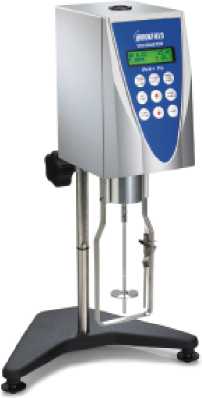
Рис. 2. Вискозиметр Brookfield RVDV-II+Pro
И змер ени е в я з к о сти вып олнен о с п о мо щ ью р от аци онн о г о в и с к о з и мет р а B r o o kf ield RVD V-II+Pro ( ри с. 2) при ком на т ной тем пе ра т уре (25 ±0,5 °С). Н е обх од и мое количе с тв о водоу гол ьного топ л и в а пом еща л ос ь в м е рный с т а ка н ци л и ндр иче с кой ф орм ы диа м е тром 100 м м . Шпи ндел ь вис козим етр а пом е ща л с я в с така н по ц е нтр у. Из м е ре н ия пров оди л ис ь в 2 этапа : 1) с корос ть с двига п л а вно у в еличивалась от 50 до 20 0 об / м ин; 2) с корос ть с дв и га пл ав но ум е н ь ша л а с ь от 200 до 50 об/ м ин .
Результаты и обсуждение
П о ре з у л ьта та м экспе рим ентов у с танов л ено, ч т о в се ис с л ед уе м ые с ос т а в ы топ лив а явл яю тс я ди л а та н тн ы м и жид кос тям и, та к ка к их вяз кос ть увеличивается с увеличением ск орости сд в ига .
Сравнение вязкости образцов выполнено при одинаковой скорости сдвига – 100 об/мин. На рис. 3–5 показано влияние концентрации различных видов жидкой горючей компоненты на динамическую вязкость топлива на основе угля марки 3Б, Д и Т.
Анализ результатов позволяет сделать вывод о том, что вязкость суспензионного топлива на основе угля марки 3Б повышается на 20,9 % при добавлении 3 мас. % изопропилового спирта, на 36,9 % – при добавлении 3 мас. % жидких отходов пиролиза РТИ и на 43,8 % – при добавлении 3 мас. % отработанного моторного масла относительного ВУТ без добавления жидкой горючей компоненты. Вязкость суспензионного топлива на основе угля марки 3Б увеличивается на 34,6 % при добавлении 5 мас. % изопропилового спирта, на 42,6 % – при добавлении 5 мас. % жидких отходов пиролиза РТИ и на 53,7 % – при добавлении 5 мас. % отработанного моторного масла относительного ВУТ без добавления жидкой горючей компоненты. Вязкость суспензионного топлива на основе угля марки 3Б возрастает на 47,3 % при добавлении 8 мас. % изопропилового спирта, на 54,5 % – при добавлении 8 мас. % жидких отходов пиролиза РТИ и на 62,3 % – при добавлении 8 мас. % отработанного моторного масла относительного ВУТ без добавления жидкой горючей компоненты. Вязкость суспензионного топлива на основе угля марки 3Б повышается на 63,1 % при добавлении 12 мас. % изопропилового спирта, на 64,3 % – при добавлении 12 мас. % жидких отходов пиролиза РТИ и на 69,8 % – при добавлении 12 мас. % отработанного моторного масла относительного ВУТ без добавления жидкой горючей компоненты.
Экспериментально определено, что вязкость суспензионного топлива на основе угля марки Д повышается на 14,2 % при добавлении 3 мас. % изопропилового спирта, на 41,5 % – при добавлении
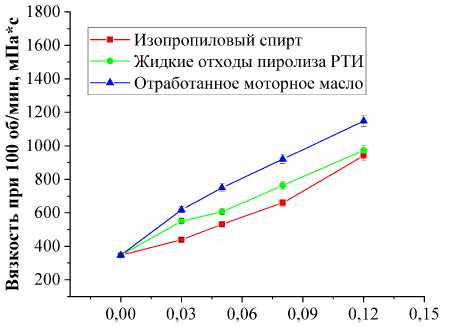
Количество жидкой горючей компоненты, мае. ед.
Рис. 3. Влияние концентрации различных видов жидкой горючей компоненты на динамическую вязкость топлива на основе угля марки 3Б
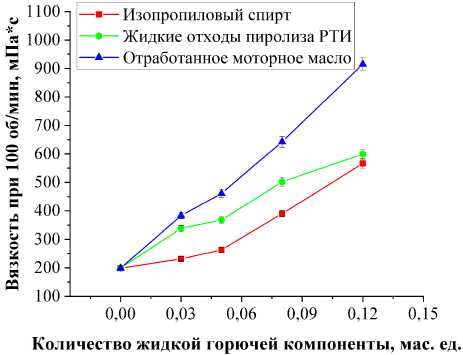
Рис. 4. Влияние концентрации различных видов жидкой горючей компоненты на динамическую вязкость топлива на основе угля марки Д
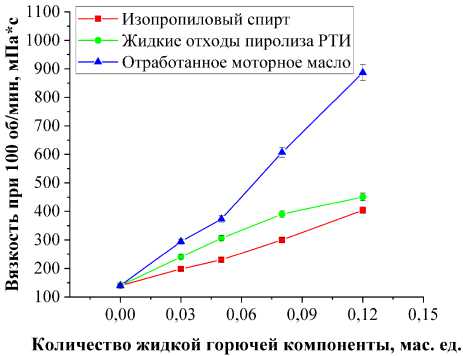
Рис. 5. Влияние концентрации различных видов жидкой горючей компоненты на динамическую вязкость топлива на основе угля марки Т
3 мас. % жидких отходов пиролиза РТИ и на 48,3 % – при добавлении 3 мас. % отработанного моторного масла относительного ВУТ без добавления жидкой горючей компоненты. Вязкость суспензионного топлива на основе угля марки Д увеличивается на 24,7 % при добавлении 5 мас. % изопропилового спирта, на 46,1 % – при добавлении 5 мас. % жидких отходов пиролиза РТИ и на 56,9 % – при добавлении 5 мас. % отработанного моторного масла относительного ВУТ без добавления жидкой горючей компоненты. Вязкость суспензионного топлива на основе угля марки Д возрастает на 49,1 % при добавлении 8 мас. % изопропилового спирта, на 60,5 % – при добавлении 8 мас. % жидких отходов пиролиза РТИ и на 69,1 % – при добавлении 8 мас. % отработанного моторного масла относительного ВУТ без добавления жидкой горючей компоненты. Вязкость суспензионного топлива на основе угля марки Д повышается на 64,9 % при добавлении 12 мас. % изопропилового спирта, на 66,9 % – при добавле- нии 12 мас. % жидких отходов пиролиза РТИ и на 78,3 % – при добавлении 12 мас. % отработанного моторного масла относительного ВУТ без добавления жидкой горючей компоненты.
Установлено, что вязкость суспензионного топлива на основе угля марки Т повышается на 29,3 % при добавлении 3 мас. % изопропилового спирта, на 41,7 % при добавлении 3 мас. % жидких отходов пиролиза РТИ и на 52,4 % – при добавлении 3 мас. % отработанного моторного масла относительного ВУТ без добавления жидкой горючей компоненты. Вязкость суспензионного топлива на основе угля марки Т увеличивается на 39,1 % при добавлении 5 мас. % изопропилового спирта, на 54,2 % – при добавлении 5 мас. % жидких отходов пиролиза РТИ и на 62,5 % – при добавлении 5 мас. % отработанного моторного масла относительного ВУТ без добавления жидкой горючей компоненты. Вязкость суспензионного топлива на основе угля марки Т возрастает на 53,3 % при добавлении 8 мас. % изопропилового спирта, на
600- s 500-

400-
300-
200-
200-
ВУТ изопропиловый отходы
ВУТ изопропиловый отходы
У я Я m
а
спирт
РТИ
моторное масло
Жидкая горючая компонента
б
спирт
РТИ
моторное масло
Жидкая горючая компонента
* и
С
S
М я Я
И
в
1100-u 1000
200-
500-
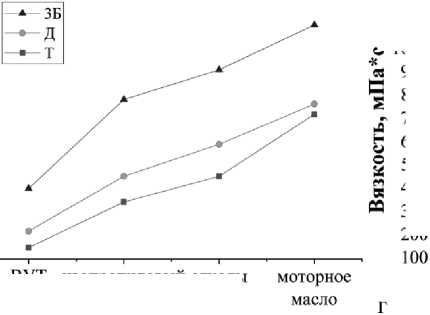
В У1 изопропиловый отходы
РТИ спирт
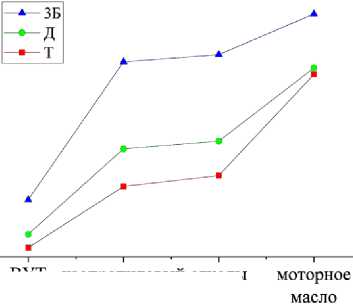
ВУТ изопропиловый отходы
РТИ спирт
Жидкая горючая компонента
Жидкая горючая компонента
Рис. 6. Зависимость динамической вязкости топлива от типа жидкой горючей компоненты и ее концентрации (угли марки 3Б, Д и Т): а – 3 % жидкой горючей компоненты; б – 5 % жидкой горючей компоненты: в – 8 % жидкой горючей компоненты; г – 12 % жидкой горючей компоненты
-
64,1 % – при добавлении 8 мас. % жидких отходов пиролиза РТИ и на 76,9 % – при добавлении 8 мас. % отработанного моторного масла относительного ВУТ без добавления жидкой горючей компоненты. Вязкость суспензионного топлива на основе угля марки Т повышается на 65,3 % при добавлении 12 мас. % изопропилового спирта, на 68,9 % – при добавлении 12 мас. % жидких отходов пиролиза РТИ и на 84,2 % – при добавлении 12 мас. % отработанного моторного масла относительного ВУТ без добавления жидкой горючей компоненты.
На рис. 6 представлена зависимость динамической вязкости топлива от типа жидкой горючей компоненты для углей марки 3Б, Д и Т при ее различных концентрациях.
По результатам проведенных экспериментов установлено, что добавление жидкой горючей компоненты приводит к повышению вязкости получаемого водоугольного топлива. При этом изопропиловый спирт вызывает наименьшее увеличение данного параметра, а отработанное моторное масло приводит к наибольшему приросту. Также установлено, что вязкость водоугольного топлива неравномерно увеличивается с ростом концентрации жидкой горючей компоненты.
Определено, что из трех исследуемых марок углей суспензионное топливо на основе угля марки 3Б обладает наибольшей вязкостью, а суспензионное топливо на основе угля марки Т – наименьшей. Это связано с их степенью метаморфизма и, соответственно, средним размером пор. Установлено, что уголь марки 3Б имеет наибольший средний размер пор (18,4 нм), уголь марки Т – наименьший (11,9 нм). Средний размер пор угля марки Д составляет 16,6 нм.
Заключение
Согласно результатам проведенных экспериментальных исследований можно сделать три основных вывода:
-
1. Вязкость суспензионного топлива на основе углей марки 3Б, Д и Т увеличивается при добавлении жидкой горючей компоненты ввиду того, что их вязкость выше вязкости воды.
-
2. Вязкость суспензионного топлива на основе углей марки 3Б, Д и Т увеличивается с ростом концентрации жидкой горючей компоненты, так как происходит замещение менее вязкой воды более вязким веществом.
-
3. Из трех исследуемых марок углей суспензионное топливо на основе угля марки 3Б обладает
наибольшей вязкостью, а суспензионное топливо на основе угля марки Т – наименьшей.
Тем не менее вязкость и текучесть водоугольного топлива при добавлении исследуемых жидких горючих компонент (в предложенных концентрациях) остается в допустимых пределах.
Таким образом, можно сделать вывод о возможности применения водоугольного топлива с добавлением небольшого количества различных жидких горючих компонент в топках котельных агрегатов тепловых электрических станций и локальных котельных, работающих на ВУТ.
Работа выполнена при финансовой поддержке Минобрнауки РФ в рамках реализации проекта FSWW-2020-0022.
Список литературы Влияние жидких горючих компонент на вязкость водоугольного топлива
- IEA (2019), "World Energy Outlook 2019", IEA, Paris. Available at: https://www.iea.org/reports/world-energy-outlook-2019 (accessed 20.05.2020).
- Yang J., Wu J., He T., et al. Energy Gases and Related Carbon Emissions in China. Resources, Conservation and Recycling, 2016, vol. 113, pp. 140-148. DOI: 10.1016/j.resconrec.2016.06.016
- Wu H., Shi Y., Xia O., et al. Effectiveness of the Policy of Circular Economy in China: a DEA-Based Analysis for the Period of 11th Five-Year-Plan. Resources, Conservation and Recycling, 2014, vol. 83, pp. 163-175. DOI: 10.1016/j.resconrec.2013.10.003
- Li J., Zhang Y., Tian Y., et al. Reduction of Carbon Emissions from China's Coal-Fired Power Industry: Insights from the Province-Level Data. Journal of Cleaner Production, 2020, vol. 242, 118518. DOI: 10.1016/jjclepro.2019.118518
- Ren Y., Wu O., Wen M., et al. Sulfur Trioxide Emissions from Coal-Fired Power Plants in China and Implications on Future Control. Fuel, 2020, vol. 261, 116438. DOI: 10.1016/j.fuel.2019.116438
- Aust H. Air Filtration and power generation: Flue gas desulphurization. Filtration & Separation, 2007, vol. 44, no. 10, pp. 36-37. DOI: 10.1016/S0015-1882(07)70325-7
- Sun W., Shao Y., Zhao L., et al. Co-Removal of CO2 and Particulate Matter from Industrial Flue Gas by Connecting an Ammonia Scrubber and a Granular Bed Filter. Journal of Cleaner Production, 2020, vol. 257, 120511. DOI: 10.1016/j.jclepro.2020.120511
- Gusnawan P.J., Zou L., Zhang G., et al. Performance and Stability of a Bio-Inspired Soybean-Based Solvent for CO2 Capture from Flue Gas. Chemical Engineering Journal, 2020, vol. 385, 123908. DOI: 10.1016/j.cej.2019.123908
- Cheng J., Zhu Y., Zhang Z., et al. Modification and Improvement of Microalgae Strains for Strengthening CO2 Fixation from Coal-Fired Flue Gas in Power Plants. Bioresource Technology, 2019, vol. 291, 121850. DOI: 10.1016/j.biortech.2019.121850
- Larionov K.B., Gromov A.A. Non-Isothermal Oxidation of Coal with Ce(NO3)3 and Cu(NO3)2 Additives. International Journal of Coal Science and Technology, 2019, vol. 6, no. 1, pp. 37-50. DOI: 10.1007/s40789-018-0229-y
- Kuznetsov G.V., Jankovsky S.A., Tolokolnikov A.A., et al. Mechanism of Sulfur and Nitrogen Oxides Suppression in Combustion Products of Mixed Fuels Based on Coal and Wood. Combustion Science and Technology, 2019, vol. 191, no. 11, pp. 2071-2081. DOI: 10.1080/00102202.2018.1543285
- Yelverton T., Brashear A.T., Nash D.G., et al. Characterization of Emissions from a Pilot-Scale Combus-tor Operating on Coal Blended with Woody Biomass. Fuel, 2020, vol. 264, 116774. DOI: 10.1016/j.fuel.2019.116774
- Zhang Y., Shen Z., Zhang B., et al. Emission Reduction Effect on PM2.5, SO2 and NOx by Using Red Mud as Additive in Clean Coal Briquetting. Atmospheric Environment, 2019, vol. 223, 117203. DOI: 10.1016/j.atmosenv.2019.117203
- Kurgankina M.A., Nyashina G.S., Strizhak P.A. Prospects of Thermal Power Plants Switching from Traditional Fuels to Coal-Water Slurries Containing Petrochemicals. Science of the Total Environment, 2019, vol. 671, pp. 568-577. DOI: 10.1016/j.scitotenv.2019.03.349
- Baranova M.P., Kulagin V.A., Tarabanko V.E. Nature of Stabilization of Water-Coal Fuel Suspensions. Russian Journal of Applied Chemistry, 2011, vol. 84, no. 6, pp. 939-944. DOI: 10.1134/s1070427211060073
- Shukla S.C., Kukade S., Mandal S.K., et al. Coal-Oil-Water Multiphase Fuel: Rheological Behavior and Prediction of Optimum Particle Size. Fuel, 2008 vol. 87, no. 15-16, pp. 3428-3432. DOI: 10.1016/j.fuel.2008.05.027
- Liu J., Wang R., Gao F., et al. Rheology and Thixotropic Properties of Slurry Fuel Prepared Using Municipal Wastewater Sludge and Coal. Chemical Engineering Science, 2012, vol. 76, pp. 1-8. DOI: 10.1016/j.ces.2012.04.010
- Chen R., Wilson M., Leong Y.K., et al. Preparation and Rheology of Biochar, Lignite Char and Coal Slurry Fuels. Fuel, 2011, vol. 90, no. 4, pp. 1689-1695. DOI: 10.1016/j.fuel.2010.10.041
- Zhang K., Cao Q., Jin L., et al. A Novel Route to Utilize Waste Engine Oil by Blending It With Water and Coal. Journal of Hazardous Materials, 2017, vol. 332, pp. 51-58. DOI: 10.1016/j.jhazmat.2017.02.052
- Boylu F., Dinger H., Ate§ok G. Effect of Coal Particle Size Distribution, Volume Fraction and Rank on the Rheology of Coal-Water Slurries. Fuel Processing Technology, 2004, vol. 85, no. 4, pp. 241-250. DOI: 10.1016/S0378-3820(03)00198-X
- Konduri M., Fatehi P. Alteration in Interfacial Properties and Stability of Coal Water Slurry by Lignosulfonate. Powder Technology, 2019, vol. 356, pp. 920-929. DOI: 10.1016/j.powtec.2019.09.019
- Atesok G., Boylu F., Sirkeci A.A., et al. The effect of coal properties on the viscosity of coal-water slurries. Fuel, 2002, vol. 81, no. 14, pp. 1855-1858. DOI: 10.1016/S0016-2361(02)00107-2

